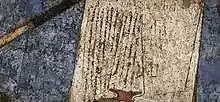Varkhuman
Varkhuman, also Vargoman (c. 640-670 CE)[1][2] was an Ikhshid (King) of Sogdia, residing in the city of Samarkand in the 7th century CE. He succeeded King Shishpin.[3] He is known from the murals of Afrasiyab in Samarkand, where is seen being visited by embassies from numerous countries, including China.[4] There is also an inscription in the murals directly mentioning him.[4] His name is also known from Chinese histories.[4]
_Palace_Fresco_7th-8th_cent_Sogdian_Varkhuman_King_of_Samarkand.jpg.webp)
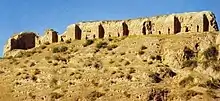
._Varkhuman._Circa_CE_650-675.jpg.webp)
One of the murals show a Chinese Embassy carrying silk and a string of silkworm cocoons to the local Sogdian ruler.[4] The scene depicted in the Afrasiyab murals probably occurred soon after 658 CE, when the Tang Dynasty had conquered the Western Turkic Khaganate.[5]
Varkhuman was a nominal vassal to the Chinese.[6] He is mentioned in the Chinese annals:
During the Yonghui (永徽) era (650-655), Kao-ti (emperor Gaozong) made this territory the Government of Kangju, and gave the title of Governor to the King of the country, Fou-hou-man
— Chinese annals on Varkhuman.[7]
Varkhuman's legacy was short-lived, as his palace was destroyed by the Arab general Sa'id ibn Uthman between 675 and 677 CE. At that time, according to Narshakhi there was no king of Samarkand anymore.[6]
Inscription mentioning Varhuman
In the murals of Afrasiab, an inscription mentioning Varhuman has been found. It is written in Sogdian:
Afrasiab Sogdian inscriptionWhen King Varkhuman Unash came to him [the ambassador] opened his mouth [and said thus]: "I am Pukarzate, the dapirpat (chancellor) of Chaganian. I arrived here from Turantash, the lord of Chaganian, to Samarkand, to the king, and with respect [to] the king [now] I am [here]. And with regard to me do not have any misgivings: About the gods of Samarkand, as well as about the writing of Samarkand I am keenly aware, and I also have not done any harm to the king. Let you be quite fortunate!" And King Varkhuman Unash took leave [of him]. And [then] the dapirpat (chancellor) of Chach opened his mouth.
— Inscription on an ambassador’s robe.[8]
Afrasiab murals
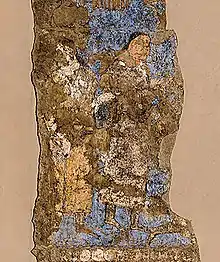
%252C_and_Chach_(modern_Tashkent)_to_king_Varkhuman_of_Samarkand._648-651_CE%252C_Afrasiyab%252C_Samarkand.jpg.webp)
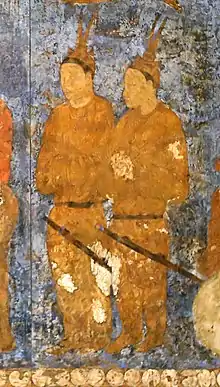
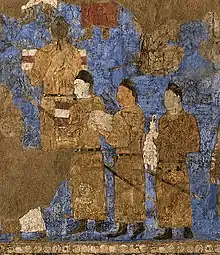 Tang Dynasty emissaries at the court of Varkhuman in Samarkand carrying silk and a string of silkworm cocoons, 648-651 CE, Afrasiyab murals, Samarkand
Tang Dynasty emissaries at the court of Varkhuman in Samarkand carrying silk and a string of silkworm cocoons, 648-651 CE, Afrasiyab murals, Samarkand
References
- Whitfield, Susan. The Silk Road: Trade, Travel, War and Faith. British Library. Serindia Publications, Inc. p. 112. ISBN 978-1-932476-13-2.
- Azarpay, Guitty; Belenickij, Aleksandr M.; Maršak, Boris Il'ič; Dresden, Mark J. Sogdian Painting: The Pictorial Epic in Oriental Art. University of California Press. p. 17. ISBN 978-0-520-03765-6.
- Baumer, Christoph. History of Central Asia, The: 4-volume set. Bloomsbury Publishing. p. 243. ISBN 978-1-83860-868-2.
- Whitfield, Susan. The Silk Road: Trade, Travel, War and Faith. British Library. Serindia Publications, Inc. p. 110. ISBN 978-1-932476-13-2.
- Whitfield, Susan. The Silk Road: Trade, Travel, War and Faith. British Library. Serindia Publications, Inc. p. 112. ISBN 978-1-932476-13-2.
- Baumer, Christoph. History of Central Asia, The: 4-volume set. Bloomsbury Publishing. p. 243. ISBN 978-1-83860-868-2.
- Mode, Markus (2006). "READING THE AFRASIAB MURALS: SOME COMMENTS ON RECONSTRUCTIONS AND DETAILS" (PDF). Rivista degli studi orientali. 78: 108. ISSN 0392-4866.
- "Afrosiab Wall Painting". contents.nahf.or.kr. NORTHEAST ASIAN HISTORY FOUNDATION.
- Baumer, Christoph. History of Central Asia, The: 4-volume set. Bloomsbury Publishing. p. 243. ISBN 978-1-83860-868-2.
- Baumer, Christoph. History of Central Asia, The: 4-volume set. Bloomsbury Publishing. p. 243. ISBN 978-1-83860-868-2.
- Library, British. The Silk Road: Trade, Travel, War and Faith. Serindia Publications, Inc. p. 110. ISBN 978-1-932476-13-2.
- Baumer, Christoph. History of Central Asia, The: 4-volume set. Bloomsbury Publishing. p. 243. ISBN 978-1-83860-868-2.
- Grenet, Frantz (2004). "Maracanda/Samarkand, une métropole pré-mongole". Annales. Histoire, Sciences Sociales. 5/6: Fig. C.
